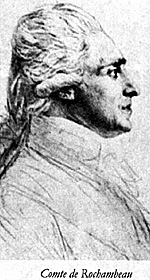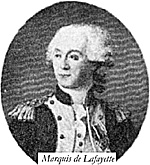
I apologise for using the 'F' word in this article.
Comte de Rochambeau.
No, not the one that gets 'bleeped' on TV - the other 'F' word, 'French'. Yes, the guy who has Brunswickers and believes the only good thing to come out of France is …. well I'll think of one later… has finally gone out to build a French army. But, I am not building just any French army. There is no 5'2" gray-coated megalomaniac-controlled pretty boys for me! These guys come from a much more elegant age when a King who played with his locks for a hobby ruled France, while his Queen was only to willing to oblige young handsome army officers with her favours [promotion was such a precarious thing in the old Royal army, performance could be everything – in HRH's bedchamber! – Ed.]
From a time just before insanity reared its ugly head and Louis and Marie-Antoinette lost theirs. Its an interesting time when trying to decide what to paint next. You have a look to see what's in the boxes that are gathering dust in the cupboard, just to make sure of what you already have. Then try and find out what every one else has, just to make sure you have an opponent. After all, what's the point in painting a beautiful 25mm Imperial Bidalonian army based to some obscure rule set you got off the Internet if there is nobody with a Republican Bidalonian army to play against?
My decision was based on a gap that existed in the ranks of the 'Illawarra Irregulars'. We often play American War of Independence, and although the British, American and German forces are well represented there were no French. I did start to wonder why and came up with a couple of reasons. Firstly they did not take part in many operations, two of those being sieges. Secondly, until recently with the release of the Old Glory range the other option for figures appeared to be Minifigs, which, to me, was not an option at all.
There are other figures out there from companies such as Front Rank, Foundry, Dixon and Hinchcliffe. However, Old Glory and Minifigs were more readily available than the others were. [1st Corps have just released a range of suitable SYW figures that are also well worth a look -Ed.] Just a quick note on the Old Glory range, their infantry figures for this period are quite nice with a variety of poses in each pack. At AUS$48.00 for 30 figures (infantry) they are reasonably priced. The only problem at this time is the lack of French artillery. Hopefully this deficiency will soon be rectified. Some players have commented on the lack of facial detail on Old Glory figures. This may have been true for earlier releases. However, the French infantry are a more recent release and much improved.
So, after deciding to adopt these fun-loving Frenchmen, what did they get up to in America? The significant role they played is quite an interesting story.
The French Arrive
The French arrived 'fashionably' late for the proceedings with their first land operation being an abortive amphibious operation by 4,000 French troops supported by their fleet and under the command of Admiral the Comte D'Estaing. The aim of this operation was to assist the American forces, commanded by General Sullivan, capture Newport during the Rhode Island campaign of 1778. The operation was a total failure. Both D'Estaing and Sullivan can be blamed for the disjointed way in which this operation was handled. Sullivan in his letters to Washington was quite happy to blame the French and a series of anti-French riots in Boston resulted.
D'Estaing's second operation in America occurred a year later, in 1779. This time, taking 3,600 French regular and colonial troops from the West Indies to recapture Savannah, Georgia, from the British. Along with his own force, 2,500 Americans commanded by General Lincoln were also involved. The siege lasted about a month and after a failed assault on October 9, the French returned to their ships and headed back to the West Indies. D'Estaing returned to France.
In May 1781 a small force of 800 Frenchmen (detached companies of 5 different regiments) assisted the Spanish in the siege and capture of Pensacola, Florida. This small operation marked the high point of direct Spanish involvement in the war. The indirect involvement of the Spanish was of greater importance.
Treaties between France and Spain meant that French army and navy units based in the West Indies were able to take direct action in America. The most influential engagement involving French troops occurred at Yorktown, Virginia in September 1781.
Under the command of Lieutenant General the Comte de Rochambeau, a veteran of the Seven Years War, the French expeditionary force arrived in America in February 1780. This force of 4,000 - 5,000 troops was made up of four regiments of infantry, Lausan's Legion of German volunteers as well as field and siege artillery. For Napoleonic players, it is interesting to note that Yorktown is one of the first uses of Gribeauval designed artillery that was to play such an important role in Napoleon's army. The French army was originally intended to be an independent force with its own commander.
 However, the Marquis de Lafayette (right) suggested that French troops be subject to General Washington's command to ensure harmony between the armies. This suggestion was adopted but Rochambeau was given command and promoted to Lieutenant General to avoid arguments over seniority. Rochambeau's promotion was a blow to Lafayette who wanted command of this force for himself. In addition to Rochambeau's force
there were a further 3,000 troops, comprising infantry, cavalry, marines and artillery commanded by the Marquis de Saint-Simon that had
been transported from the West Indies by Admiralde Grasse.
However, the Marquis de Lafayette (right) suggested that French troops be subject to General Washington's command to ensure harmony between the armies. This suggestion was adopted but Rochambeau was given command and promoted to Lieutenant General to avoid arguments over seniority. Rochambeau's promotion was a blow to Lafayette who wanted command of this force for himself. In addition to Rochambeau's force
there were a further 3,000 troops, comprising infantry, cavalry, marines and artillery commanded by the Marquis de Saint-Simon that had
been transported from the West Indies by Admiralde Grasse.
There is the opinion that without the support of the French army and navy, victory at Yorktown would not have been achieved. Considering that the French army contributed some 7,000 - 8,000 troops to the siege force, and a fleet of 36 ships that prevented the escape or resupply of the British garrison, then this opinion would appear to be quite valid.
French Organization and Uniforms
More American War of Independence
-
AWI Hessians: Historical Background
AWI Hessians: Hessian Recruitment and Performance
AWI Hessians: German Troops in America, by Unit
AWI Hessians: Wargamer Introduction
AWI Hessians: Miniatures
Battle of Lexington Scenario
-
AWI Lexington: Introduction
AWI Lexington: American Player Notes
AWI Lexington: British Player Notes
AWI Lexington: Referee Summary
Back to Table of Contents -- Kriegspieler #7
To Kriegspieler List of Issues
To MagWeb Master Magazine List
© Copyright 1999 by Kriegspieler Publications.
This article appears in MagWeb (Magazine Web) on the Internet World Wide Web.
Other military history articles and gaming articles are available at http://www.magweb.com